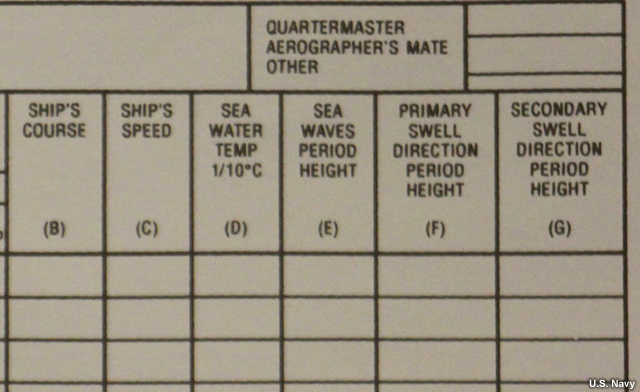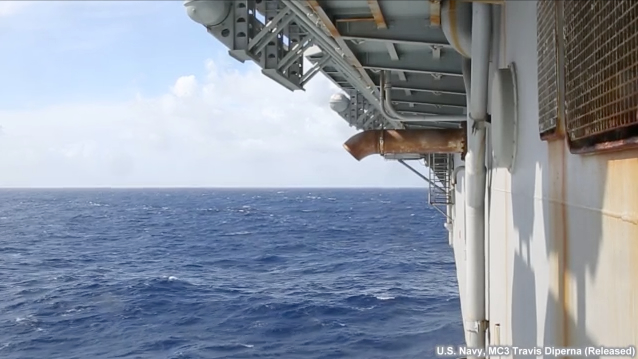Your Observation and Report
You stand at a low level on the Kearsarge and observe the seas. Look at the waves visible from your vantage point on the Kearsarge and estimate their heights, periods, and direction. The ship is sailing due east.
Based on your view of the seas, determine the wind wave direction, period, and height and the swell wave direction, period, height. If a value cannot be determined enter NA for Not Applicable.
Type your answers in the boxes, then click Done.
From the video, we can obtain these estimates of wave height, period, and direction:
Wind waves: direction 80 degrees; period 1 second; height 3 feet
Primary swell waves: direction 150 degrees; period 4 seconds; height 7 feet
There is no secondary swell.
To encode your wind wave observation, report the height and period. The direction of the wind waves should be the same as the wind direction. For the purposes of the reporting form wind waves are called "Sea Waves."
For swell waves, report the height, period, and direction. The direction should be encoded as two digits by entering the hundreds and tens of degrees (for example, 220 degrees is encoded as 22; 80 degrees is encoded as 08). For your METAR, the wave heights are encoded in feet. Note that wave heights are reported differently for METARs than in the synoptic code. When wave heights are encoded for synoptic observations using the WMO FM 13 SHIP code, the heights are reported in half meters, using the values specified in Table III-4-4.
Based on the estimates of wind wave height, period, and direction, how would you encode these values for your METAR? The values will be reported in column E of the reporting form.

Type your answer in the boxes below, then click Done.
The correct answers are a period of 01 and height of 03. For your METAR, enter the period in seconds followed by the wave height in feet as two digits.
Based on the estimates of the swell wave height, period, and direction, how would you encode them in column F on the reporting form for your METAR? Type your answer in the boxes, then click Done.
The correct answers are a direction of 15, period of 04 and height of 07. For your METAR, swell is encoded based on direction (tens and units), period (seconds--tens and units), and height (feet--tens and units) in column F for primary swell and column G for secondary swell. Secondary swell must differ in direction from the primary swell by at least 30 degrees and is observed very rarely. In this case, Column G contains 000000 because no secondary swell was observed.
